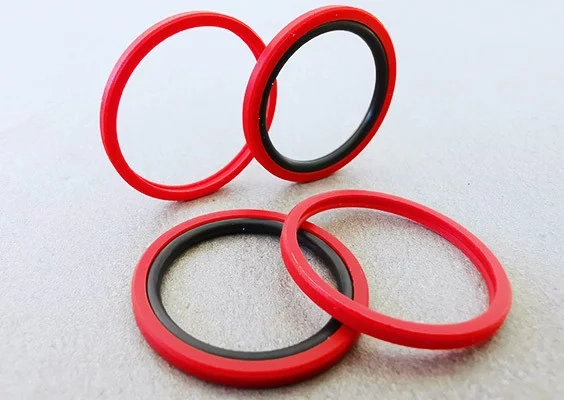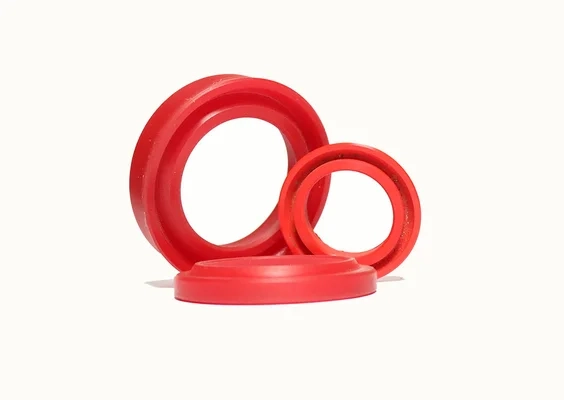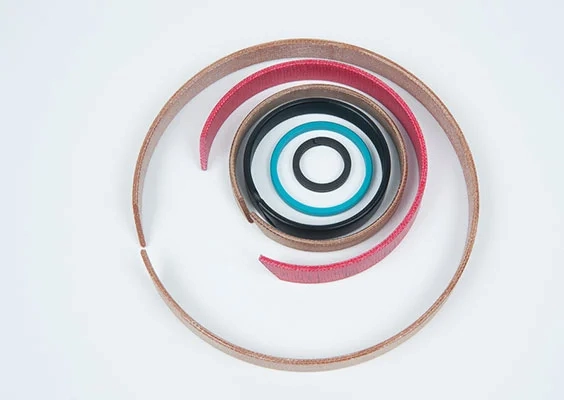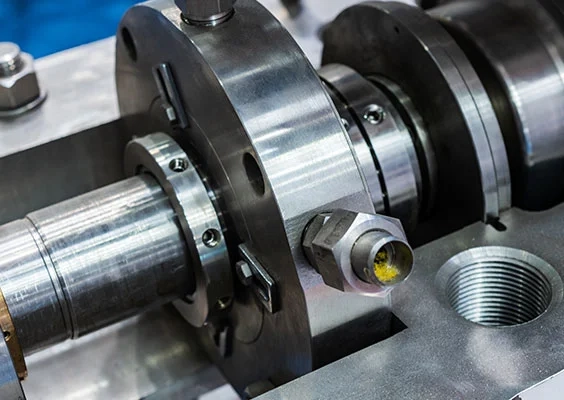-
Homepage
-
Sealing knowledge
- Hydraulic Seals
What are hydraulic seals?
In engineering, hydraulic seals are essential components of numerous modern machines. A hydraulic seal isolates components or chambers within a machine from each other, as well as the interior of a machine from its environment. They prevent the ingress of air, moisture, and dirt, as well as the escape of gases and liquids. High-quality seals for the industry and trade are therefore indispensable.
Hydraulic seals are critical components in fluid power applications, where the controlled movement of liquids like oil or water generates mechanical force. The transmission medium in hydraulics is water (or oil), in contrast to pneumatics (pneumatic seal), which operates with air. Hydraulics, therefore, is the study of the flow behavior of various fluids in a hydraulic cylinder.
In this article, we want to introduce you to the foundations of hydraulic sealing, rod seals, and piston seals. Essential for efficient operational life are also wipers and guide elements, whose function, as well as profile and material options, we will explain in this article. We will also discuss individual sealing systems, since these are often the best choice in sealing technology. Learn about all the information on seals for various industries. Whether you need standard parts or a custom seal design, our team will assist you in finding the optimal solution.

Hydraulic Seals - Dynamic Seals
Hydraulic seals fall into the category of dynamic seals. In general, a distinction is made between static seals, i.e. between stationary parts (for example in the case of flange connections) and dynamic seals, in which a component is typically in motion (e.g. in the case of rotating shafts or retracting and extending pistons in a reciprocating cylinder). Shaft seal, rotary seals and seal ring.
In addition, there is also the hydrostatic field of application, in which the seals must ensure that, for example, a cylinder must remain in the same position for a longer period of time. In high-pressure systems, buffer seals are often used in combination with rod and piston seals to absorb pressure peaks and protect primary seals.
In general, hydraulic seals separate a pressurized fluid from its surroundings. In this case, the sealing gap is located between a moving piston and the housing or cylinder. The hydraulic seal has the following functions:
- minimizes the ingress of air, humidity
- prevents the penetration of dirt, dust and other impurities
- prevents the escape of hydraulic fluid from the pressure system, while ensuring the retraction and extension of the piston.
We are experienced experts and can manufacture the hydraulic seals and provide complete sealing solutions tailored to your requirements and areas of application.
Hydraulic Cylinder Seals and Seal Kits
Are you looking for complete hydraulic cylinder seal kits and seals? We at Kofler - Dichtungen offer standard sealing sets in metric and inch sizes or custom-made products and repair kits. We can also develop and mass-produce gasket sets of the gaskets below for you and your applications. We provide repair kits and sealing solutions for popular machinery brands, including Bobcat loader and excavators.
We supply various sectors with our seals: construction, food industry, wood industry, energy technology, tunnel construction, automotive, and agricultural and municipal technology. We also supply aftermarket seal kits for maintenance and repair of hydraulic systems. Our range covers seals for lift cylinders, steering cylinders, and other high-pressure hydraulic components. All seals can be supplied as OEM-quality parts or customized for specific applications. For easy identification and ordering, each seal or kit is available with a dedicated part number.

Hydraulic Seal Kit - How is the Hydraulic Seal Constructed?
A hydraulic cylinder seal set consists of several seals that are used in hydraulics. In the best case, all individual sealing elements work in harmony. It is important to coordinate the seal for hydraulic applications. Correct sizing for the cylinder bore is essential to ensure proper sealing performance and prevent wear. The respective materials used play a decisive role in determining whether the entire hydraulic cylinder seal set works in the long term.
The seals for the hydraulics are divided into piston seals, rod seals, rotary seals, grooved rings, back-up rings, scrapers and guide rings. Our seals are engineered to resist extrusion and deformation under extreme pressure and temperature conditions. We can deliver precision machined seals for prototypes, small batches, or urgent repairs.
Hydraulic Rod Seal
Rod seals seal the exit point of the piston rod from the cylinder. They are stationary in the housing, sealing statically with their outer ring. Internally, dynamic sealing occurs towards the movable rod. In many hydraulic cylinders, a head seal is combined with the rod seal to provide an additional layer of protection against fluid leakage.
Typically, rod seals are asymmetrical wiper rings or u-cup profiles whose shortened inner seal lip dynamically seals against the piston rod. The outer seal lip maintains static contact with the cylinder head. Due to the design, it's possible to apply pressure load from only one side, thus they are referred to as single-acting seals.
If sealing is not required in a pressureles s state, rod seals can be installed without pre-pressing. In operation, system pressure pushes the wiper ring against the sealing surfaces, ensuring proper tightness.
If sealing in the pressureless state is also necessary (e.g., to prevent the hydraulic fluid from leaking during storage or transport of the device), a seal with pre-pressing (installed under tension or pressure) must be used.
Hydraulic Seal: Rod Sealing Ring - Compact Rings
This pre-loading can be achieved through the shape (e.g., compact rings) or multi-part seals (e.g., groove ring + O-ring or groove ring + spring). These seals also have sufficient sealing pressure without system pressure to prevent leakage.

Get in touch with us!
We perform best under pressure! Personalized advice for the highest demands and a fast delivery guarantee ensure your satisfaction. Contact our sealing experts.
We look forward to your inquiry."
Hydraulic piston seal (compact seals)
The hydraulic piston seal distinguishes two categories, depending on whether the piston is loaded from only one side (single-acting piston seal) or is subjected to pressure loads from both sides (double-acting piston seal).
Single-acting piston seals are similar in principle to rod seals, with the difference that in single-acting piston seals the outer diameter seals dynamically, while the inner diameter sits statically on the piston (i.e. an inverse arrangement of the stationary and moving components).
Accordingly, these single-acting piston seals such as rod seals are designed as asymmetrical groove rings, except that the outer, dynamically locking sealing lip is shortened.
The double-acting piston seal (hydraulic systems with differential cylinders between two pressure ranges) can be pressure-loaded from both sides, i.e. it separates two chambers from each other, both of which can alternately be under overpressure. Such double-acting piston seals are typically designed as symmetrical groove rings or compact rings.
They have a symmetrical contact pressure curve and react extremely quickly to the pressure of the hydraulic medium. Here, too, depending on the operating conditions, pre-compression (installation under pressure, tension) may be necessary. This is achieved by the dimension and geometry of compact rings or by elastomeric O-rings. Our assembly tool for hydraulic seals is ideally suited for the installation of these seals. We also supply metallic piston rings for high-temperature or heavy-duty hydraulic applications.

Sealing Rings
Groove rings are fundamentally circular sealing elements that feature a groove, or an elongated indentation, along their diameter. This groove limits the two sealing lips that create the sealing edges for static and dynamic sealing. Depending on the application area (inner-sealing rod seals or outer-sealing piston seals), either the inner lip or the outer lip is shortened. The precise geometry of the sealing lips greatly affects the seal's effectiveness in terms of tightness and leakage rate.
Previously, elastomer O-rings and groove rings with thin sealing lips (conically tapering) were used, but these designs have become obsolete. Modern groove rings boast an optimal sealing lip profile, whose oil-side wedge gap achieves an optimal opening angle for sufficient lubrication of the seal surface while minimizing leakage (too steep: no lubrication film; too flat: thick lubrication film). This form of the sealing lips significantly enhances performance regarding stripping capability and retraction efficiency, especially under high pressure.
Groove rings are typically made from wear-resistant PU (polyurethane), low-friction, temperature- and chemical-resistant PTFE (polytetrafluoroethylene), or flexible, high-performance elastomers (NBR, nitrile butadiene rubber).
It is important to differentiate groove rings from so-called compact rings, where the space between the sealing edges is filled with elastomer.
Besides hydraulic applications, we also manufacture oil seals designed for rotary shafts and lubrication systems. We are experienced experts and are happy to advise you on the most suitable material for your specific application. We help you select the best seal material based on pressure, fluid type, and temperature range.

Scraper for hydraulic applications
Scrapers are located behind the actual hydraulic seal. These are components that are in principle not exposed to any significant pressure load. Wipers have a dual function: on the one hand, they wipe dirt, dust, water and other impurities from the retracting rod to avoid contamination of the hydraulic system. On the other hand, they must allow a thin film of oil on the rod to sufficiently lubricate the seal when retracting. A balance must be ensured here, because too large an amount of oil practically represents a leak and dirt adheres more easily to the oil layer.
Depending on the required performance, sealing rings with rubber lips or special so-called double scrapers are used in hydraulics. Double scrapers have two sealing edges. The inner, oil-side sealing edge wipes off excess hydraulic fluid and leaves a sufficient lubricating film when extended. The outer sealing edge removes impurities from the retracting rod.
Typically, scrapers are made of NBR (nitrile butadiene rubber), PU (polyurethane) or PTFE (polytetrafluoroethylene). These materials are selected for their resistance to abrasion, temperature, and hydraulic fluids.
We will be happy to advise you in order to be able to manufacture the optimal hydraulic seals for your area of application.

Guide elements seals
Guide element seals allow the straight retraction and extension of the hydraulic rod and prevent occurring transverse forces from leading to contact with the metallic parts or other damage in the hydraulic system.
Hydraulic seals are designed to absorb large forces from the pressurized hydraulic medium, but may be sensitive to transverse, crushing, and shear forces. Guide rings absorb such forces and align the rod or piston centrally, so that wedging, scratching, scoring of the metallic components and destruction of the hydraulic seal by crushing or tearing can be avoided.
Depending on the field of application, guide elements can be designed as a guide ring or guide band. There are a wide variety of geometries and several materials to choose from. In addition to guide bands, wear rings are used to reduce friction and protect metallic components from direct contact.
When using high-performance seals, it is particularly expedient to also install the corresponding matching guide elements, because premature wear or defect of such a seal is not economical.
We will be happy to advise you in order to be able to manufacture the optimal hydraulic seals for your area of application.


Get in touch with us!
We perform best under pressure! Personalized advice for the highest demands and a fast delivery guarantee ensure your satisfaction. Contact our sealing experts.
We look forward to your inquiry."
Hydraulic sealing systems for demanding applications
Hydraulic sealing systems are deployed in particularly demanding applications that require high levels of sealing effectiveness and durability. In some cases, a single hydraulic seal may not provide enough power to meet specific requirements, such as extreme cold, heat, or significant contamination in the workplace.
In such scenarios, a multi-component sealing system is advisable, with each component's functionality complementing the others. A sealing system, for example, may comprise one or more hydraulic seals along with guiding elements and wipers. Given the extensive variety of combination possibilities, we are keen to offer personalized consultation to create the ideal sealing system tailored to your application needs.
Our product range includes seals for hydraulic and pneumatic systems, among others, as well as specialized seals (with article numbers), spare parts, support rings, thread sealing (thread), and flat seals. Our range also includes complete seal assemblies for complex hydraulic and pneumatic systems. Additionally, we provide high-performance materials such as Viton® and elastomers. Our seals are also used in hydraulic actuators, where precision and durability are crucial for reliable motion control.
All our sealing products are manufactured according to ISO quality standards. At Kofler - Dichtungen, you can purchase your hydraulic seals or contact us for expert advice tailored to your needs.

FAQ abou hydraulic seals
What are hydraulic seals used for?
What is the difference between a rod seal and a piston seal?
How do O-Rings fit into hydraulic sealing systems?
What is a wiper seal?
Order your hydraulic seals
As a leading manufacturer and distributor, we can supply hydraulic seals that are tailor-made for your requirements and areas of application.
